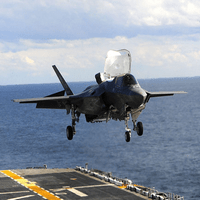On Monday, an F-35B Lightning II Joint Strike Fighter completed its first vertical landing at sea, aboard the amphibious assault ship USS Wasp. The F-35B has been the most troubled of the problem-beset F-35 family, suffering from a variety of teething pains as well as concerns about range, payload and stealth characteristics. As the Defense Department worries about austerity, some have targeted the F-35, and the B model in particular, for cuts. A recent article in the Marine Corps Gazette suggested that the United States Marine Corps, heretofore the strongest proponent of the F-35B, should abandon the aircraft in favor of a mix of F-22 Raptors and light attack aircraft.
Given Congress' unwillingness to pursue additional revenue, the current Defense Department budget cannot be sustained. Cuts will be necessary, but the F-35B is the wrong place to look. The F-35B provides a virtually unique capability for transforming amphibious assault ships into light strike/air superiority aircraft carriers. In export and international production, the F-35B can similarly transform warships such as the Japanese Hyuga-class Helicopter-Carrying Destroyer into light carriers capable of strike and air superiority missions. The F-35B is a force multiplier in the literal sense: It turns amphibious warships with limited strike capabilities into aircraft carriers roughly as capable as their most formidable foreign counterparts.
The pursuit of aircraft that could perform conventional roles from small aircraft carriers is nothing new. During the Cold War, both NATO and the Soviet Union attempted to develop vertical or short takeoff and landing (VSTOL) fighter aircraft that could conduct strike and air superiority missions with constrained deck space. The United Kingdom and the United States developed the Harrier "jump jet" family, including the AV-8A Harrier, the AV-8B Harrier II and the Sea Harrier. The Royal Navy used the Sea Harrier to devastating effect against the Argentine air force during the Falklands War, achieving 20 air-to-air kills against no losses, although one Sea Harrier was lost to ground fire. The Sea Harriers flew from relatively small British aircraft carriers, including HMS Invincible and HMS Hermes. Soviet efforts were somewhat less successful. The Yak-38 "Forger" was intended to perform strike and air superiority missions from the Soviet Navy's four Kiev-class aircraft carrier/cruisers. However, the aircraft had such a limited range and armament, and performed so poorly in high heat and humidity conditions, that Soviet pilots referred to it as "a pigeon of peace." For the most part, naval aviators resigned themselves to the fact that aircraft with high-performance capabilities would require large-deck aircraft carriers and catapult- or in some cases ski-jump-assisted takeoffs.

